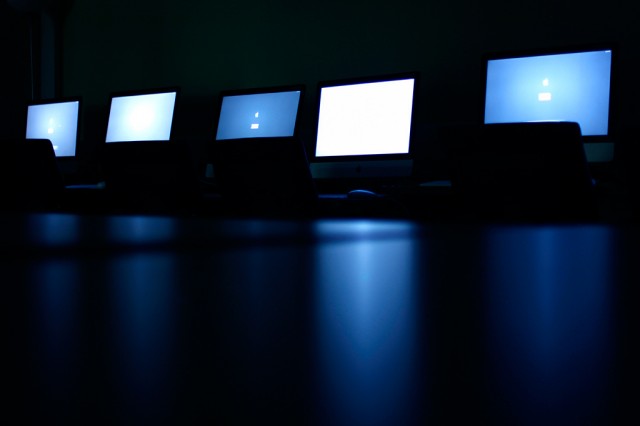Desktops Left on Overnight a Power Drain at UT Austin

Most of UT’s 30,000 desktops are left on overnight, wasting energy and money. These monitors at the Jesse J. Jones Communication Center are an example. Photo by Thalia Juarez/Reporting Texas
By Helen Fernandez
For Reporting Texas
Computers left on after buildings are locked at night at the University of Texas waste thousands of dollars worth of electricity, but the university as yet has no comprehensive strategy to address the issue.
The campus has an estimated 30,000 desktops, said Kevin Almasy, a university spokesman.
They can each use between 28 and 80 watts an hour when in idle mode, depending on their type. Most computers are not set to go into sleep mode when they’re not used for an extended period, which uses less power, spokespeople said.
That translates to between 4.6 million and 13.3 million kilowatt hours of electricity a year, based on calculations from UT’s Energy and Water Conservation Program and assuming that most campus buildings are closed for 48 hours a week.
So UT is wasting approximately $280,000 a year, at minimum, by leaving computers on when buildings are not occupied. The university’s electricity bill in 2011-12 was about $8 million, according to the UT Energy Management website.
University spokespeople said the desktops are left on to allow routine maintenance and security checks, something that typically happens when classes aren’t in session.
UT prides itself on its strides toward energy conservation. Pains were taken to ensure that major new buildings, the Belo Center for New Media and the Liberal Arts building, would qualify for certification under the Leadership in Energy and Environmental Design rating system, created by the U.S. Green Building Council.
But the certification does not take into account computer energy waste, said Adam Pruitt, coordinator of the council’s Central Texas-Balcones chapter.
In 2006, Yale University did a study showing the campus could save $400,000 a year by turning off computers at the end of each workday.
Yale’s facilities department conducted an experiment in which it had employees switch off some computers after programming the machines to come back on at night for updates and maintenance and then shut down again, according to a case study by Energy Star, an energy-conservation initiative of the U.S. Environmental Protection Agency.
Since then, the department has been routinely turning its own computers off at night, with exceptions for laptops and other computers that are used 24 hours a day.
Matt Stevens, an energy steward with UT’s Facilities Services, said his department uses a software called Verdiem for 1,200 of its own computers and plans to recommend it to other departments.
Verdiem allows IT departments “to pump updates and throw (desktops) right back to sleep,” he said. The 1,200 computers that have been using Verdiem managed to save the department $45,000 since being installed in 2009.
“Since each IT department makes its own decision, we’re either going to have to go through central IT and have them push it out or we’re going to have to go around each IT department,” Stevens said.
Anna Theimer, manager of UT’s Energy and Water Conservation Program, said there are several problems with using the software campus-wide.
“Security, privacy, and the ability for IT to perform its functions, among other factors, all need to be considered and vetted before we implement across campus.,” she said.
Stevens said UT plans to reduce campus energy and water use by 20 percent by the year 2020.
Among UT’s green initiatives is Longhorn Lights Out, which encourages students, faculty and staff to volunteer to turn off lights, unplug unnecessary electronics and power down computer equipment.
Since the program started in April 2013, it has helped save nearly 44,500 kilowatt hours of electricity, said Stephanie Perrone, senior project manager at the Energy and Water Conservation Program
Ross Baldick, an electrical and computer engineering professor at UT, said Longhorn Lights Out is “a symbolic activity.” “It gets people to think about energy, but the amount of savings is trivial,” Baldick said.
Dave Tuttle, a UT professor in the Department of Electrical and Computer Engineering, said that he understands the challenge of balancing the needs of users who have to keep the computers on all the time and their goal of reducing energy power consumption.
“They have to work with every single user, group, or department to try to educate or negotiate ways to reduce power consumption,” said Tuttle. “Sometimes an IT group can’t reduce the power consumption without harming the fundamental computing function so critically needed by the users of the computers.”